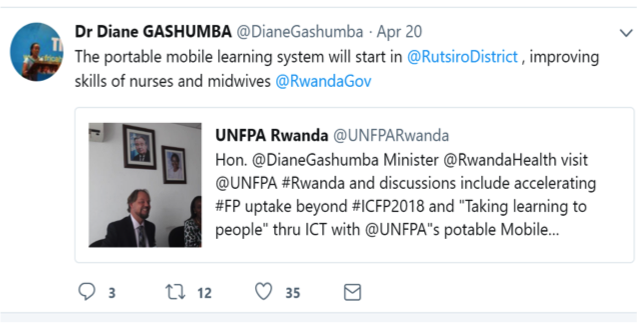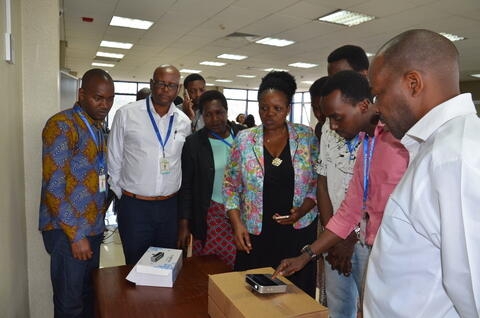Technology driven approaches offer a good solution, particularly in light of Rwanda’s efforts to reach the most remote areas of the country, and to leave no one behind. In this regard, Rwanda has prioritized investment in innovative technological solutions for its contemporary development challenges to achieve results elaborated in the National Transformative results and aims to reach ‘high middle-income’ status by 2035. On this journey, Rwanda is being challenged to increase its health expenditure, in order to ensure the entire population has access to a wide range of high quality health services.
As external funding for health shows declining trends, the Government of Rwanda has been looking at innovative solutions to ensure the health needs of the entire population are addressed. The government, together with partners, including UNFPA, is increasingly engaged in skilling up healthcare professionals to the highest standards and in ensuring that SRH messages are shared widely, especially among the most vulnerable youth.

Recently, Rwanda’s Health Minister, Dr. Diane Gashumba, warmly welcomed UNFPA’s Mobile Learning System (MLS) pilot initiative and immediately identified much potential in implementing the innovation in the country beyond supporting midwifery learning and capacity development. She stressed the importance of “on the job training”, taking the learning to the field using MLS, as highlighted in one of her Tweets. The MLS was launched in Rwanda in early May 2018 in the remote Rutsiro district coinciding with the International Day of the Midwife on May 5, following the positive results shown from pilots in Tanzania and Ethiopia.
The user friendly MLS comprises of a light-weight, palm sized projector, that comes with a built in android tablet, and ten pre-loaded multi-media, interactive e-learning modules, developed by UNFPA, covering all major maternal and new-born life-saving skills, such as post-partum hemorrhage, eclampsia and pre-eclampsia, sepsis, obstructed labour, and post-abortion care, that account for more than 90% of all maternal deaths. These e-learning courses could be supplemented with additional content considering the local context and accessed offline. The MLS kit also comes with speakers, a battery pack and a solar panel, which makes it suitable for remote settings with limited access to internet and electricity. Any white wall in any remote setting (even with no amenities like electricity and internet) can be used to train small groups of participants using the projector, battery and the built in multi-media modules. The health facilities will use these kits to train local health workers, especially midwives, ensuring that their key life-saving skills are enhanced.

In an interview with CNBC Africa, Mark Bryan Schreiner, the UNFPA Country Representative, reiterated the significance of “looking at how we can benefit and capitalize on those digital innovations and technological advancements to address some of the difficult challenges we have in achieving the social transformation that we are looking for in the continent”, in particular by supporting technology that helps youth gain access to SRH information and services.
As the Government of Rwanda continues its journey towards an innovative knowledge-led economy to achieve the country’s ambitious health targets, the importance of linking prevention efforts with digital technology cannot be underscored enough. Within this supportive and conducive environment and within the framework of UNFPA’s Innovation Strategy, the interdivisional nature of UNFPA’s technical support has been instrumental in raising the bar to expand our efforts. Powerful partnerships and innovation are needed to ensure not only that no one is left behind but that youth in particular, which represent the majority of the population (nearly 60%), are at the center of the country’s social and economic transformation.



